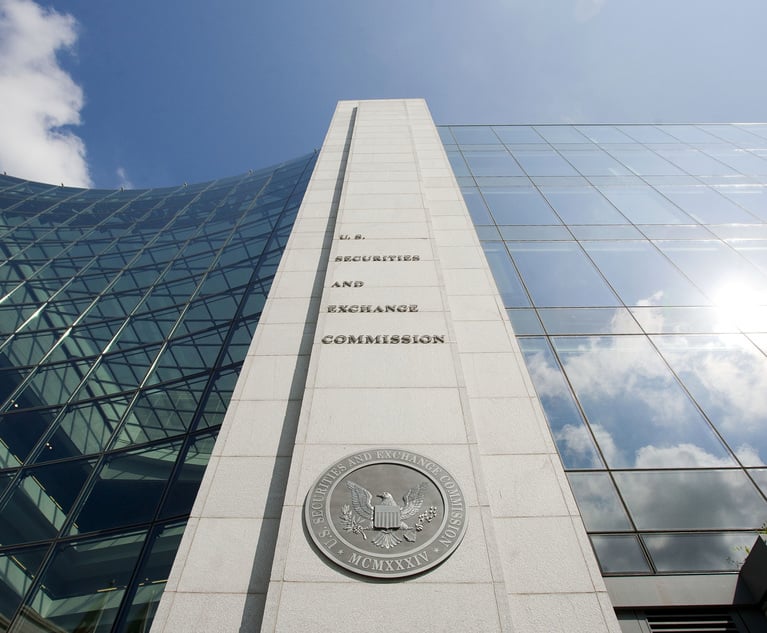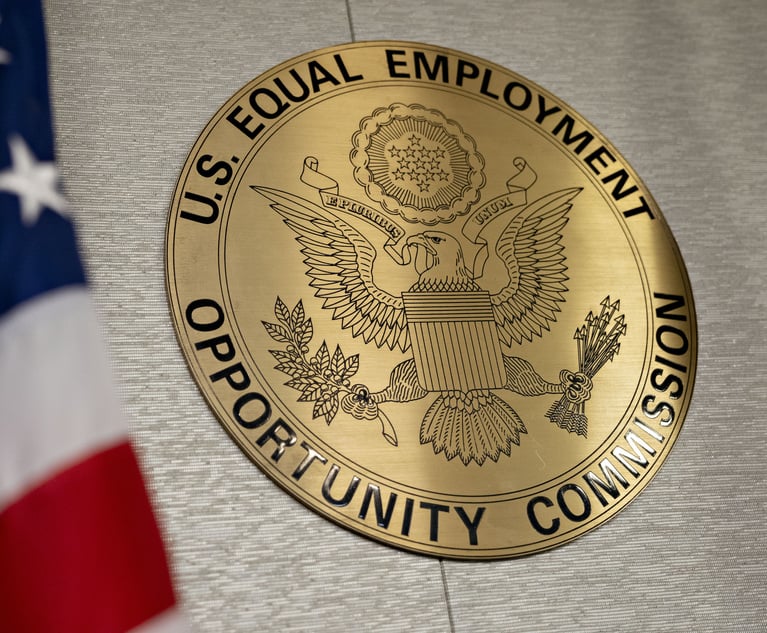Securities class actions decline in 2012
According to two recent studies, securities class actions were down in 2012a welcome announcement for embattled Corporate America, which faced strings of post-recession lawsuits tied to the financial crisis.
March 25, 2013 at 08:00 PM
10 minute read
To read about the Supreme Court's Amgen decision and its impact on securities class actions, click here.
According to two recent studies, securities class actions were down in 2012—a welcome announcement for embattled Corporate America, which faced strings of post-recession lawsuits tied to the financial crisis.
A study from Cornerstone Research and the Stanford Law School Securities Class Action Clearinghouse reported 152 federal securities class actions last year compared with 188 in 2011. Filings against large companies were at their lowest point in 13 years in 2011 and 2012. Additionally, filings against companies in the financial sector dropped from 43 in 2010 to 15 in 2012, and 2012 was the first year since the recent credit crisis in which there were no new credit crisis-related filings.
A separate study from NERA Economic Consulting reported similar findings (the numbers differ from Cornerstone and Stanford's report due to variations in the organizations' tallying methodologies). NERA reported 207 securities class actions filings in 2012 compared with 225 in 2011. The study also found that the number of resolutions of such cases dropped to a record low, with 152 dismissed or settled in 2012 compared with 244 in 2011. And last year's 152 resolutions included only 93 settlements—a record low since 1996 and a 25 percent drop from 2011.
Uncovering Reasons
Experts say there are two major reasons this decline in securities class actions occurred: a drop in both the number of filings concerning Chinese reverse mergers and filings concerning mergers and acquisitions (M&A). According to Cornerstone and Stanford's report, those two types of filings together accounted for just 23 filings in 2012 compared with 74 in 2011.
Roughly five years ago, there was an influx of Chinese companies that obtained listings on the U.S. exchange by merging with publicly traded shell companies. This strategy—the Chinese reverse merger—enabled Chinese companies to bypass regulatory procedures related to the initial public offering (IPO) process.
“As a result, a number of these companies have had problems, including accounting scandals, that led to securities class action lawsuits,” says Kevin LaCroix, executive vice president at RT ProExec, a management liability insurance intermediary. LaCroix has written extensively about the drop in securities class actions on his blog, “The D&O Diary.”
Recent data shows that Chinese reverse merger suits peaked in 2011 and began dropping off last year. “It's not likely that we'll see a resurgence in those kinds of cases” because the Chinese reverse merger phenomenon is phasing out, says Ronald Miller, vice president of NERA.
On the M&A front, experts say there were fewer M&A transactions in 2012, particularly in the second half of the year. The drop in M&A activity led to a concurrent drop in related securities class actions. Cornerstone and Stanford's study reported just 13 securities class action filings related to M&A transactions last year compared with 43 in 2011.
Trendless Year
John Gould, senior vice president of Cornerstone Research, says there is another reason securities class actions declined last year. “There simply was no big trend,” he says. “In the past few years, we've seen filings related to IPOs, options backdating, subprime mortgages, the credit crisis … there's usually some sort of trend, and we just didn't have one in 2012.”
LaCroix agrees. “The absence of any event-driven flow of litigation meant that there was a little bit of a lull in securities class actions,” he says.
Nonetheless, the plaintiffs bar was still busy filing nonclass action securities suits. “They allege violations of securities laws, and they seek significant damages, but they don't seek to represent a class of claimants; they're only representing individual or groups of claimants,” LaCroix says.
According to LaCroix, institutional clients such as large European banks and European pension funds are pursuing individual suits against big investment banks and mortgage-related entities instead of class actions because they frequently had face-to-face meetings with these entities and received specific representations that weren't made to anybody else.
“If [plaintiffs lawyers] have a big institutional client that claims to have lost millions and millions of dollars, and they have a nice, deep-pocketed defendant that they can sue, that's a pretty good combination,” LaCroix says.
Looking Ahead
Experts say it's too early in the year to predict how securities class actions will unfurl in 2013, but they say litigation could pick up again.
“It's been a nice year for in-house counsel, but the expectation is that filings will come back to where they were,” Gould says.
LaCroix says last year's lag in securities class actions was just part of the natural ebb and flow of such litigation. And although there so far hasn't been any event that has attracted an influx of litigation, LaCroix does have one theory of a possible trigger. “There's been a lot in the press about cybersecurity and cyber hacks, and the Securities and Exchange Commission has made it clear that it considers disclosures around privacy and cybersecurity issues to be a priority,” he says. “I could definitely see a sequence of events where a company has a problem, it becomes public, their share price takes a hit and a securities lawsuit comes in.”
To read about the Supreme Court's Amgen decision and its impact on securities class actions, click here.
According to two recent studies, securities class actions were down in 2012—a welcome announcement for embattled Corporate America, which faced strings of post-recession lawsuits tied to the financial crisis.
A study from Cornerstone Research and the
A separate study from NERA Economic Consulting reported similar findings (the numbers differ from Cornerstone and Stanford's report due to variations in the organizations' tallying methodologies). NERA reported 207 securities class actions filings in 2012 compared with 225 in 2011. The study also found that the number of resolutions of such cases dropped to a record low, with 152 dismissed or settled in 2012 compared with 244 in 2011. And last year's 152 resolutions included only 93 settlements—a record low since 1996 and a 25 percent drop from 2011.
Uncovering Reasons
Experts say there are two major reasons this decline in securities class actions occurred: a drop in both the number of filings concerning Chinese reverse mergers and filings concerning mergers and acquisitions (M&A). According to Cornerstone and Stanford's report, those two types of filings together accounted for just 23 filings in 2012 compared with 74 in 2011.
Roughly five years ago, there was an influx of Chinese companies that obtained listings on the U.S. exchange by merging with publicly traded shell companies. This strategy—the Chinese reverse merger—enabled Chinese companies to bypass regulatory procedures related to the initial public offering (IPO) process.
“As a result, a number of these companies have had problems, including accounting scandals, that led to securities class action lawsuits,” says Kevin LaCroix, executive vice president at RT ProExec, a management liability insurance intermediary. LaCroix has written extensively about the drop in securities class actions on his blog, “The D&O Diary.”
Recent data shows that Chinese reverse merger suits peaked in 2011 and began dropping off last year. “It's not likely that we'll see a resurgence in those kinds of cases” because the Chinese reverse merger phenomenon is phasing out, says Ronald Miller, vice president of NERA.
On the M&A front, experts say there were fewer M&A transactions in 2012, particularly in the second half of the year. The drop in M&A activity led to a concurrent drop in related securities class actions. Cornerstone and Stanford's study reported just 13 securities class action filings related to M&A transactions last year compared with 43 in 2011.
Trendless Year
John Gould, senior vice president of Cornerstone Research, says there is another reason securities class actions declined last year. “There simply was no big trend,” he says. “In the past few years, we've seen filings related to IPOs, options backdating, subprime mortgages, the credit crisis … there's usually some sort of trend, and we just didn't have one in 2012.”
LaCroix agrees. “The absence of any event-driven flow of litigation meant that there was a little bit of a lull in securities class actions,” he says.
Nonetheless, the plaintiffs bar was still busy filing nonclass action securities suits. “They allege violations of securities laws, and they seek significant damages, but they don't seek to represent a class of claimants; they're only representing individual or groups of claimants,” LaCroix says.
According to LaCroix, institutional clients such as large European banks and European pension funds are pursuing individual suits against big investment banks and mortgage-related entities instead of class actions because they frequently had face-to-face meetings with these entities and received specific representations that weren't made to anybody else.
“If [plaintiffs lawyers] have a big institutional client that claims to have lost millions and millions of dollars, and they have a nice, deep-pocketed defendant that they can sue, that's a pretty good combination,” LaCroix says.
Looking Ahead
Experts say it's too early in the year to predict how securities class actions will unfurl in 2013, but they say litigation could pick up again.
“It's been a nice year for in-house counsel, but the expectation is that filings will come back to where they were,” Gould says.
LaCroix says last year's lag in securities class actions was just part of the natural ebb and flow of such litigation. And although there so far hasn't been any event that has attracted an influx of litigation, LaCroix does have one theory of a possible trigger. “There's been a lot in the press about cybersecurity and cyber hacks, and the Securities and Exchange Commission has made it clear that it considers disclosures around privacy and cybersecurity issues to be a priority,” he says. “I could definitely see a sequence of events where a company has a problem, it becomes public, their share price takes a hit and a securities lawsuit comes in.”
This content has been archived. It is available through our partners, LexisNexis® and Bloomberg Law.
To view this content, please continue to their sites.
Not a Lexis Subscriber?
Subscribe Now
Not a Bloomberg Law Subscriber?
Subscribe Now
NOT FOR REPRINT
© 2025 ALM Global, LLC, All Rights Reserved. Request academic re-use from www.copyright.com. All other uses, submit a request to [email protected]. For more information visit Asset & Logo Licensing.
You Might Like
View All

‘Extremely Disturbing’: AI Firms Face Class Action by ‘Taskers’ Exposed to Traumatic Content
5 minute read
In-House Lawyers Are Focused on Employment and Cybersecurity Disputes, But Looking Out for Conflict Over AI
Trending Stories
- 1New York-Based Skadden Team Joins White & Case Group in Mexico City for Citigroup Demerger
- 2No Two Wildfires Alike: Lawyers Take Different Legal Strategies in California
- 3Poop-Themed Dog Toy OK as Parody, but Still Tarnished Jack Daniel’s Brand, Court Says
- 4Meet the New President of NY's Association of Trial Court Jurists
- 5Lawyers' Phones Are Ringing: What Should Employers Do If ICE Raids Their Business?
Who Got The Work
J. Brugh Lower of Gibbons has entered an appearance for industrial equipment supplier Devco Corporation in a pending trademark infringement lawsuit. The suit, accusing the defendant of selling knock-off Graco products, was filed Dec. 18 in New Jersey District Court by Rivkin Radler on behalf of Graco Inc. and Graco Minnesota. The case, assigned to U.S. District Judge Zahid N. Quraishi, is 3:24-cv-11294, Graco Inc. et al v. Devco Corporation.
Who Got The Work
Rebecca Maller-Stein and Kent A. Yalowitz of Arnold & Porter Kaye Scholer have entered their appearances for Hanaco Venture Capital and its executives, Lior Prosor and David Frankel, in a pending securities lawsuit. The action, filed on Dec. 24 in New York Southern District Court by Zell, Aron & Co. on behalf of Goldeneye Advisors, accuses the defendants of negligently and fraudulently managing the plaintiff's $1 million investment. The case, assigned to U.S. District Judge Vernon S. Broderick, is 1:24-cv-09918, Goldeneye Advisors, LLC v. Hanaco Venture Capital, Ltd. et al.
Who Got The Work
Attorneys from A&O Shearman has stepped in as defense counsel for Toronto-Dominion Bank and other defendants in a pending securities class action. The suit, filed Dec. 11 in New York Southern District Court by Bleichmar Fonti & Auld, accuses the defendants of concealing the bank's 'pervasive' deficiencies in regards to its compliance with the Bank Secrecy Act and the quality of its anti-money laundering controls. The case, assigned to U.S. District Judge Arun Subramanian, is 1:24-cv-09445, Gonzalez v. The Toronto-Dominion Bank et al.
Who Got The Work
Crown Castle International, a Pennsylvania company providing shared communications infrastructure, has turned to Luke D. Wolf of Gordon Rees Scully Mansukhani to fend off a pending breach-of-contract lawsuit. The court action, filed Nov. 25 in Michigan Eastern District Court by Hooper Hathaway PC on behalf of The Town Residences LLC, accuses Crown Castle of failing to transfer approximately $30,000 in utility payments from T-Mobile in breach of a roof-top lease and assignment agreement. The case, assigned to U.S. District Judge Susan K. Declercq, is 2:24-cv-13131, The Town Residences LLC v. T-Mobile US, Inc. et al.
Who Got The Work
Wilfred P. Coronato and Daniel M. Schwartz of McCarter & English have stepped in as defense counsel to Electrolux Home Products Inc. in a pending product liability lawsuit. The court action, filed Nov. 26 in New York Eastern District Court by Poulos Lopiccolo PC and Nagel Rice LLP on behalf of David Stern, alleges that the defendant's refrigerators’ drawers and shelving repeatedly break and fall apart within months after purchase. The case, assigned to U.S. District Judge Joan M. Azrack, is 2:24-cv-08204, Stern v. Electrolux Home Products, Inc.
Featured Firms
Law Offices of Gary Martin Hays & Associates, P.C.
(470) 294-1674
Law Offices of Mark E. Salomone
(857) 444-6468
Smith & Hassler
(713) 739-1250







